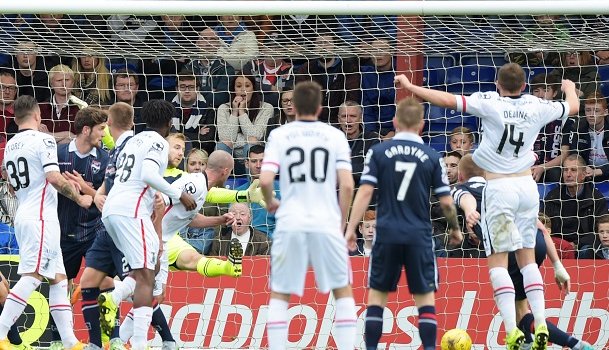Craig Cairns takes his latest tactical look at the Ladbrokes Premiership, with the focus this week on Inverness Caley Thistle and St Johnstone.
Caley Thistle’s first-half performance wins the Highland derby
Inverness CT’s resilience this season has been quite remarkable. Their player exits and injuries have been well-documented but they have managed to get through a tricky start with just three defeats from their first 10 matches – the same number as Dundee, Ross County, Hamilton Accies and Hearts, who all currently sit in the top six.
Their depleted squad has forced manager John Hughes to rethink his strategy and has seen him take more of a counter-attacking approach. This has resulted in them drawing more matches than any other side in the league.
For this match they were also missing the suspended Ryan Christie, who had scored three and assisted five of their nine goals until Saturday. Luckily, they still possess a goal threat in Miles Storey, who has now scored four goals in his five matches since arriving on loan from Swindon.
This column has pointed how successful Ross County have been from crossing the ball into the box in recent times. Hughes fielded Liam Polworth and James Vincent - who are not natural wingers - on the sides of a 4-2-3-1, meaning they were more inclined to take up more reserved, narrow positions.
The result was that, without the ball, Inverness were able to race back into position effectively, crowd out the usually influential Jackson Irvine and stop the supply to the wide areas. Consequently the supply to the strikers, namely Liam Boyce, was also stopped. Just one opportunity was created for the prolific striker in the first 45 minutes, which he ambitiously attempted to scissor-kick.
Inverness’s defensive line was particularly deep, giving their in-form opponents the respect they deserve, and Storey’s strength and speed provided them with a perfect out-ball. Time and again they looked to get the ball to him as quickly as possible.
Their two goals displayed the two ways Inverness attack teams at the moment. The first saw Andrea Mbuyi-Mutombo win the ball in the left-back area before starting off a passing move that involved eight different players, including the entire back four. The second was from a corner and the result of Storey being given a ball to chase.
Ross County dominated the second half and Boyce eventually got his obligatory goal – his 11th of the season – but it wasn’t enough to get them back into the game. The win leaves Inverness unbeaten in their last six. They, like St Johnstone, are a side on the rise after a difficult start.
Prolific St Johnstone catch the eye
In recent seasons, St Johnstone have built a reputation of being slow starters to the league campaign. This season was no different but they have certainly made up for it in recent weeks.
Their last three results have seen them score 10 goals, win at Ibrox and come from 1-0 down with 10 men to win against Dundee United. All before firing five goals past an Aberdeen side who had started the season with eight wins and five clean sheets. St Johnstone now sit just outside the top six and, if previous seasons are anything to go by, this upward trajectory should eventually see them challenge for European places once again.
Tommy Wright’s side have had a reputation of being built upon a solid backline but with enough in attack to hurt their opposition. This season they have evolved into one of the most exciting teams in the country.
They have failed to keep a clean sheet in 12 attempts. The flip side is that they have scored in all but one of these matches – their first European tie versus Alashkert back at the beginning of July – and are the Ladbrokes Premiership’s second-highest scorers behind Celtic, with 21 goals.
Much of this has been down to the form of Michael O’Halloran, whose pace and power has seen him consistently take the ball into dangerous positions, usually behind the opposition left-back, where he likes to drill the ball low across the goal. He has assisted six goals in all competitions by such means but was unavailable for Saturday’s trip to Pittodrie.
His team didn’t miss him. Wright responded by fielding Simon Lappin just ahead of Brian Easton on the left, a tactic he used at Ibrox and which kept James Tavernier quiet for large parts of that match. Similarly, in this game, Niall McGinn struggled to make his usual mark from the right wing. Wright deployed a similar tactic on the other side for the final 20 minutes, withdrawing David Wotherspoon in favour of Darnell Fisher, in order to protect the lead.
A resurgent Steven MacLean scored his seventh and eighth goals of the season to cap off the victory. Graham Cummins, with whom he has forged a deadly partnership, took his assist tally to five – the Irishman has also netted four times – and played a part in two of the other goals.
St Johnstone scored four goals from set-pieces at the weekend, three of them corners. Cummins’ strength and aerial ability helped them profit against an Aberdeen side whose players are not exactly diminutive in stature.
Another key component of this side is Dave Mackay. Wright pointed out post-match that they had improved defensively over the previous month and much of this has been a result of the club captain settling into his new role.
Always a consistent performer, Mackay has been converted to centre-back where he has marshalled the defence to victory over two of the most prolific sides in the country in recent weeks. He and his manager will be desperate for that elusive clean sheet but won’t be too bothered they conceded in this match.





.png)












